Maindy Velodrome: Last remnant of Wales' biggest event
 Geograph/ Alan Murray Rust
Geograph/ Alan Murray RustSome of the last traces of arguably the biggest event ever to be hosted in Wales are set to disappear.
With 1,130 athletes from 35 countries descending on Cardiff, experts believe the country may never see the like of the 1958 British Empire and Commonwealth Games again.
Little remains of the venues used, with the Sophia Gardens Pavilion demolished in 1982 and the Empire Pool in 1998.
The velodrome at Maindy could soon be bulldozed too under plans.
It is the last remnant of an event sports author Huw Richards believes trumps the 1999 Rugby World Cup as the biggest hosted here.
"As soon as you set foot in the Arms Park, and saw the gathering of elite athletes from all over the globe, you could feel a sense that Wales had become a grown-up member of the world community," is how cultural historian Prof Peter Stead described the games.
For younger generations, Maindy Velodrome is best known for nurturing some of Wales' greatest cycling talents, including 2018 Tour de France winner Geraint Thomas.
But it is also where riders battled it out for gold in 1958.
Under proposals, an expansion of Cathays High School would see the velodrome lost, and a new track built at Cardiff Bay.
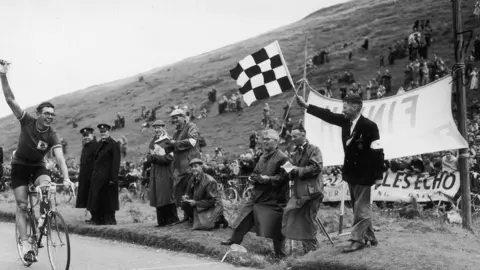 Getty Images
Getty ImagesThe club that uses it, Maindy Flyers, said the prospect of "being left with nothing for future generations of cyclists" was "unacceptable".
Cardiff council replied by saying it fully understands the site's "historic nature", but the new velodrome had the support of the national governing body for cycling.
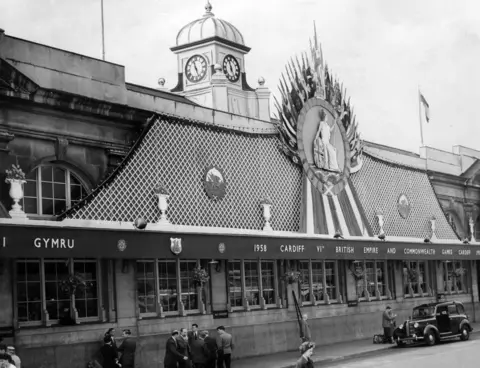 Getty Images
Getty ImagesSimilar pain was felt by the swimming community when another of the venues from 1958 disappeared.
The Empire Pool had 1,722 seats, diving boards and the country's only 50m pool - but was flattened as the Millennium Stadium rose up to dominate the city centre in the late '90s.

"The Empire Pool was an iconic facility in the heart of the capital that not only opened its doors to the world at the 1958 Empire Games, but also served to develop some of our nation's finest athletes," said Swim Wales' head of aquatics and inclusion Sioned Williams.
"To lose this piece of history was a big blow to the Welsh aquatics community."
However, she said its replacement, the Wales National Pool in Swansea has become a "thriving hub" for its elite programme and events, while there is also now an Olympic-sized pool in Cardiff Bay.
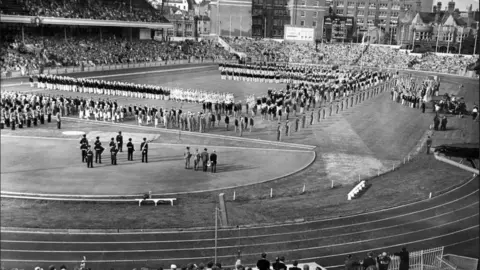 Getty Images
Getty ImagesComing three years after Cardiff was confirmed as capital, the 1958 games were "a significant moment" for the nation, according to sports historian Huw Richards.
But he added: "It has to be remembered that they were rather smaller than they have since become - with just over 1,100 athletes in 94 events, compared to 5,000 competing in 280 at the most recent games in Birmingham."
Cardiff Arms Park was where the drama on the track unfolded - but it looked very different then, a 60,000-capacity stadium where Cardiff RFC and the national rugby side played.
A series of redesigns means it now holds 12,500, with the only remaining parts the Gwyn Nicholls Memorial Gates - erected in 1949 to commemorate one of Wales' greatest rugby players.
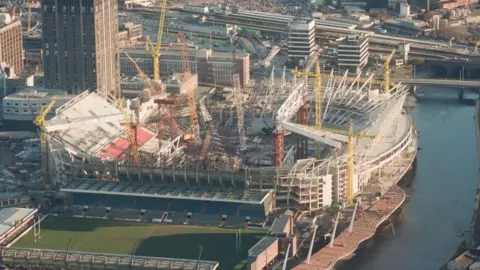 Getty Images
Getty ImagesIt stands in the shadow of the Principality Stadium next door, the site of which has also undergone massive transformation since 1958.
Work on a new National Stadium began in 1969, with it not officially opened until 1984.
But just 11 years later, it was decided to demolish it for a super-stadium to host the 1999 Rugby World Cup.
This tournament is the main rival to the 1958 games as Wales' biggest ever event - but comparisons do not stand up to scrutiny, according to Mr Richards.
"In 1999, Wales was the host of record, staging the opening game and the final, but the event was spread evenly across all of what were then the five nations," he added.
"Wales had only nine games out of 41. The other four nations got eight each and the most memorable of them, the two semi-finals, were both at Twickenham."
He said this makes it "all the odder" Wales is the only nation to build a new stadium for a Rugby World Cup.
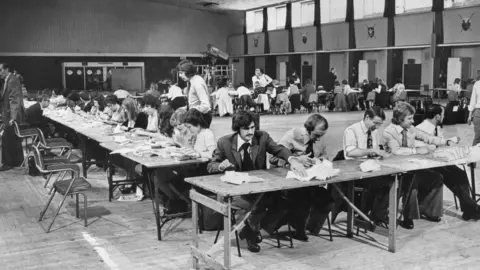 Getty Images
Getty ImagesSophia Gardens Pavilion, which hosted boxing and wrestling in 1958, was also a concert venue, with Pink Floyd and Jimi Hendrix among those appearing.
However, its end came in 1982 after its roof collapsed under heavy snow.
 Getty Images
Getty ImagesThere is one location used for the 1958 Cardiff-hosted event that remains untouched - and it is 170 miles (274 km) away.
Rowing took place on Llyn Padarn in Eryri, also known as Snowdonia.
 Getty Images
Getty ImagesOther big events to come to Wales include golf's Ryder Cup, a Champions League final and an Ashes test - but they were far shorter.
Tourism consultant Prof Terry Stevens believes if Wales was to host the Commonwealth Games again, it would probably be in collaboration with other nations.
"What used to be fairly straightforward, a cycle, is far more complicated now," he said.
"It's not just money, there are lots of other objectives of the organisers, plus TV deals. It used to be done on a 'your turn next' basis. Now it's much more nuanced, sophisticated.
"If you go back 15 years, relatively few venues could hold these big events. Now, every city has at least one decent venue - it's incredibly competitive."
Mr Stevens said sporting bodies increasingly wanted events hosted by multiple countries, such as the next World Cup in the USA, Canada and Mexico.
This puts the bid of the UK nations and Ireland for Euro 2028 in a strong position, he believes, especially considering its rival Turkey is going solo.
"It doesn't prevent Wales going alone for one-off games like the Champions League or a golf competition with one course," he added.
"The trend is Wales would have to collaborate to host the Commonwealth Games. It doesn't deny us, it's just a different model."
